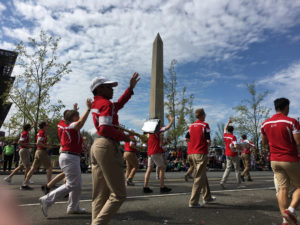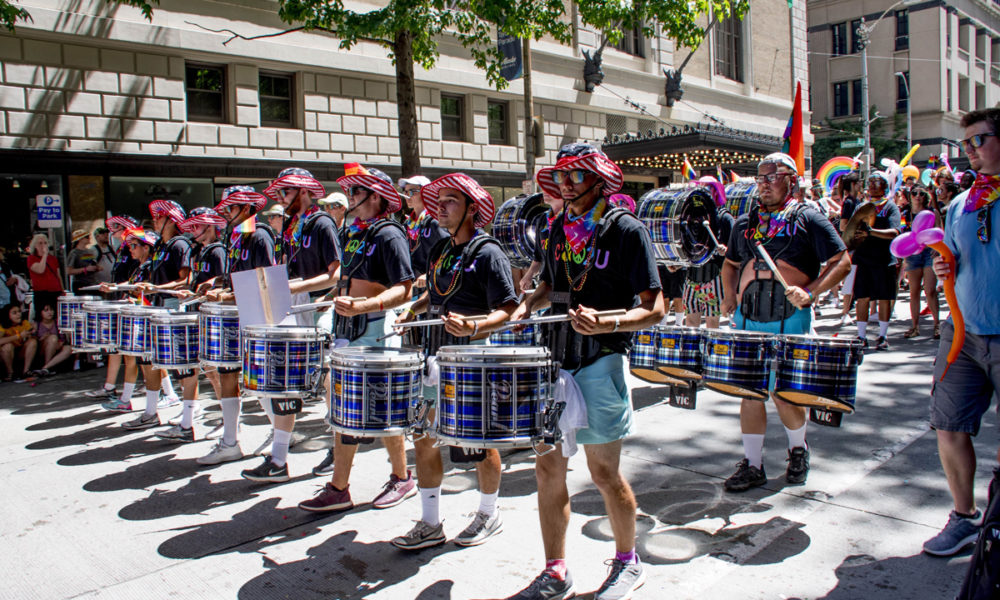Simple policies and procedures can help LGBTQ+ musicians feel welcomed and included in their marching programs.
 June 2019 is a significant month for many musicians in the LGBTQ+ community. Not only do many Pride Parades occur around the country, but it also marks the 50th anniversary of the 1969 Stonewall Riots, a series of uprisings that many consider to be the beginning of the gay rights movement.
June 2019 is a significant month for many musicians in the LGBTQ+ community. Not only do many Pride Parades occur around the country, but it also marks the 50th anniversary of the 1969 Stonewall Riots, a series of uprisings that many consider to be the beginning of the gay rights movement.
For the Lesbian & Gay Big Apple Corps (LGBAC) in New York, 2019 is an important year for another reason: It’s the group’s 40th anniversary.
Director Marita Begley, who has been a member of the LGBAC since 1981, recognizes the essential role of music education for developing kids. “I’m not shy anymore, and I owe a lot of that to marching band,” says Begley, who identifies as gay and has been involved in the marching arts since 1972. In the ’70s and ’80s, “gay was so stigmatized,” she recalls.
Begley says that students in her school’s marching band in the 1970s were bullied by non-band students, who often called them homophobic slurs.
American culture has made a lot of progress in terms of LGBTQ+ rights and acceptance since then and so have the procedures at marching bands, drum corps, and other music ensembles. From the growing prevalence of LGBTQ+ community bands to the implementation of more inclusive policies in school and competitive ensembles, the marching arts is cultivating a welcoming environment for all musicians.
Leading by Example
 As the job title suggests, a band director is responsible for setting the band’s direction when it comes to creating an inclusive environment. At every educational program, “it’s essential that the leadership—whether the conductor, teacher, or principal—is fully on board around being inclusive of young people with different backgrounds [and] life experiences,” says Ellen Kahn, director of the Children, Youth, and Families Program at the Human Rights Campaign.
As the job title suggests, a band director is responsible for setting the band’s direction when it comes to creating an inclusive environment. At every educational program, “it’s essential that the leadership—whether the conductor, teacher, or principal—is fully on board around being inclusive of young people with different backgrounds [and] life experiences,” says Ellen Kahn, director of the Children, Youth, and Families Program at the Human Rights Campaign.
Begley agrees: “What comes from the top sets the tone for the group,” she says.
Jarrett Lipman, director of bands at Claudia Taylor “Lady Bird” Johnson High School in San Antonio, Texas, remembers the example that his band directors set for him and how that influenced his own process. “I grew up in a high school band program where both directors were super supportive [and] taught us about the values of how we treat one another,” Lipman says. “[There was a lot] of emphasis on showing respect to everybody. No, ‘If this, then that.’”
Now Lipman focuses on those qualities of respect and inclusion with his own students. Working with the older members and leadership teams can be critical in fostering this positive culture. “If they see something going on, the older ones will try to step in,” he says. “We try to teach them a lot about valuing other people.”
Working with section leaders can be a key part of developing an inclusive environment. This collaboration has been one of the ways that Charles Roth, artistic marching band director for D.C.’s Different Drummers (DCDD), has been able to make sure that everyone always feels comfortable. “Most of my caption heads for brass, percussion, woodwinds—we meet, and we discuss, should we see any concerns or if something is brought up,” he says.
Leadership should also address concerns brought up by all performers. “Some young people are very outspoken, and others are not,” Begley says. “If you get feedback from the kids in the band about something, just trust it.”
Promoting a Safe Space
The importance of LGBTQ+ inclusion goes beyond working with existing students and performers. During recruitment periods, ensembles can also let prospective members know that the organization is a safe space. “Having a pride flag in your office, or just saying, ‘We’re inclusive,’ is a huge step,” says Kaitlyn Hollysmith, public relations officer for the Lakeside Pride Music Ensembles in Chicago.
Recruitment materials, like flyers and posters, can also be a great place to emphasize this message. “In materials around recruiting, be explicit that all students are welcome,” Kahn says. “Maybe you would have some LGBTQ+ specific symbols that say, ‘We want everyone to feel welcome.’”
Schools can also promote inclusion by making their students aware of LGBTQ+ community bands in their area. “We just recently started reaching out to Chicago Public Schools, letting people know that [Lakeside Pride] is an option after high school,” Hollysmith says.
Breaking Gender Barriers
Removing gender barriers is an important step toward cultivating a safe space for all musicians. To do so, avoid assuming anything about a student based on gender or outward appearance.
During one of the LGBAC’s recent meetings, band members wore nametags that said, “My name is …” and “My pronouns are …” The nametags gave pronoun options for “he/him,” “she/her,” and “they/them.”
That way, transgender and non-binary students—those who do not identify with being completely male or female—could clarify how others should refer to them.
The DCDD organization employs a similar method with a sign-in sheet that contains not only musicians’ names, email addresses, and instruments, but also their pronouns. Clarinetist Elliott Kozuch found the group’s inclusive policies useful when undergoing a legal name change to reflect their new gender identity. “The director reached out to me and said, ‘Hey, how would you like your name to look on the sign-in sheet and on the program for the next concert?’” Kozuch says.
While directors can make the effort to find out and correctly use performers’ pronouns, logistics can get more difficult with gender structures for bathrooms, changing areas, and showers.
While touring, drum corps and other ensembles separate sleeping areas and showers based on gender. The Blue Devils B (BDB) is one group that offers additional options. “We separate the gym and sleeping areas into girls and boys, but if you wanted to sleep somewhere else, you could,” says Oliver Bishop, the 2017 and 2018 drum major.
Bishop is a transgender man who has had no trouble using the men’s sleeping and shower areas while on tour with the corps. “I was able to participate like all the other boys,” he says. “The staff didn’t make it a big deal for me or the other members. They made it clear to me, ‘If you’re uncomfortable, we can give you a different shower time.’ But I wasn’t.”
The Seattle Cascades Drum and Bugle Corps has similar strategies. While most of the corps’ members will use separate showers depending on gender, the staff wants all of the musicians to feel comfortable. That could mean students changing their sleeping area or altering shower schedules. “It’s an ever-changing situation,” says Tommy Williams, executive director. “As an educator, I’ve learned that building a single bridge is not going to get to every student. You need to build bridges to get to that individual student.”
During events organized by the Lesbian and Gay Band Association, one bathroom will be designated as gender-neutral with a sign on the door to indicate that anyone can use it. “So far, no one’s complained about it,” says President Cliff Norris.
Lipman’s high school students have multiple options for changing areas, including a male space, a female space, and a private bathroom. “When a situation comes up, we’re sensitive to the fact that there may be somebody working through that,” Lipman says. “We try to be understanding and supportive.”
Bringing Students Together
In any music program, strong support systems can positively affect young people’s development in so many ways. Roth says that he originally struggled to come out as LGBTQ+ but always felt safe in band. “Being able to make music really created a sense of welcoming,” he says. “It was one of the reasons why I curated a passion to teach music. I eventually did come out, and when I did, it was the music community that really helped me express who I was.”
While music programs are a great place for students to feel accepted, it’s also important not to stress a student’s sexual orientation or gender identity. When Bishop first told his fellow corps members that he was transgender, he appreciated that nobody made a big deal out of it. “The coolest thing was that nobody did anything at all,” he says.
Bishop praises the marching arts as an activity with the potential to connect all types of people. “What I tell a lot of people that reach out to me [is]: If you’re scared, don’t be worried about it,” he says. “At the end of the day, everybody is scared. Marching band teaches you to conquer your fears.”
Part of treating all performers equally, LGBTQ+ or otherwise, comes from putting the biggest focus on the music itself and making sure that all performers feel they can perform at their best. “When a performer comes to our drum corps, it’s always about the attitude, desire, and talent,” Williams says.
In 2017, the Seattle Cascades first marched in the Seattle Pride Parade, showing support not only for LGBTQ+ musicians but also for all people in the LGBTQ+ community. According to Williams, the corps plans to perform in the parade again this summer. “We, as an organization, are proud of being all-inclusive,” he says.
In the end, inclusion seems to be a natural part of the world of music, a field that is based on collaboration. “Music is for everybody, and band is a place where everyone needs to feel safe,” Lipman says. “We don’t want those things to be what determine the experience a student has in band. The love for music should be the No. 1 thing.”


